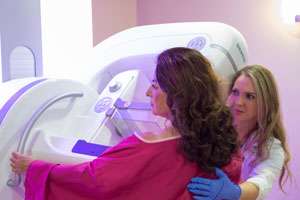Study finds 12-14 percent rate for mammogram patient callbacks increases cancer detection

Breast cancer detection increases significantly when radiologists recall mammogram patients for additional imaging more often than recommended by the current guidelines, according to a study by a radiologist at Rush. The study determined that the "sweet spot" for finding breast cancer is in the recall range of 12 to 14 percent, compared to the current guidelines of 5 to 12 percent.
"Even 10 percent, the average current recall rate, may be too low," said Dr. Paula Grabler, assistant professor in the Department of Diagnostic Radiology and Nuclear Medicine at Rush Medical College. The results of the study appeared in the January 2017 issue of the American Journal of Roentgenology.
Callback guidelines are based on outdated studies
The American College of Radiology recommends annual screening mammography for asymptomatic women beginning at age 40. The goal is to detect early-stage breast cancers in order to provide women the best prognosis for long-term, disease-free survival.
Guidelines for callbacks help set a statistical standard for radiologists, with the goal of capturing the largest possible number of breast cancers. Current national guidelines are based on studies performed prior to the near universal use of digital mammography of the practices of both breast imaging specialists and general radiologists.
The guidelines recommend that 5 to 12 percent of women presenting for screening return for additional imaging for further evaluation of a finding on their screening images (e.g., a mass, calcifications or an area of architectural distortion). Only a small number of these women recalled from screening mammography will ultimately be diagnosed with breast cancer.
Study audited results of nearly 189,000 mammograms
The medical director of breast imaging at Rush Oak Park Hospital, Grabler headed a research team that looked at the practices of 19 breast imaging radiologists at Northwestern Memorial Hospital. The study included only the practices of breast imaging specialists reading only digital mammograms with the goal to determine the optimal performance standards.
The results of the study indicated that "breast imagers ... operating at recall rates 12 percent or higher found significantly more cancers of all types, compared with those operating within the minimally acceptable 5 to12 percent recall performance." The report proposes setting a new "sweet spot" for optimal cancer detection between 12 and 14 percent. Any benefits above 14 percent were statistically insignificant, Grabler said.
Grabler's team reviewed almost 189,000 mammograms performed during the five audit years between 2007 and 2012. "The higher recall groups found significantly more invasive cancers," "including minimally invasive cancers," which offer women the best prognosis, the report states.
Second screenings can raise anxiety, and relieve it
For 25 years, the federal government has required clinics to conduct medical outcome audits to evaluate how well they're doing in detecting breast cancer. Grabler herself has performed many such audits over the years. "I have been eyeballing the data for many years, and I've had the opportunity to see the audits of many specialists," she says.
Grabler was struck by the fact that the guidelines radiologists were being encouraged to use were falling below the rates that, in practice, she saw associated with capturing the most, and most treatable, cancers. That insight led her to undertake this study, she says.
It's no small thing for a radiologist to bring a woman back to the clinic for a closer look at her breast tissue. It's "frightening" for women to hear that a radiologist has seen something on her mammogram that might be cancer, Grabler explained.
"In my practice, when women return, we inform them of the results immediately after the additional imaging. We relieve their anxiety when we can before they walk out the door," she said.
"If a biopsy is necessary, we explain the finding(s) to the patient as well as the minimally invasive procedure we are recommending. Of those patients for whom a biopsy is recommended, only a small percent will be diagnosed with breast cancer."
Early detection can mean less treatment is needed
Cancers detected on mammograms range from ductal carcinoma in situ (DCIS) to more aggressive, invasive cancers. By finding cancers early, not only are the prognoses improved, but many women may have the opportunity to undergo less treatment (e.g., to have a lumpectomy rather than mastectomy and/or be spared the need for chemotherapy).
Looking to the future, tomosynthesis, a newer, 3-D mammography technology, which will be available at Rush Oak Park Hospital this spring, may be able to detect early cancers with lower recall rates. Tomosynthesis has been demonstrated to be especially useful for women with dense breasts. Dense breast tissue may decrease the sensitivity of detecting breast cancers utilizing routine, 2-D mammography.
More information: Paula Grabler et al. Recall and Cancer Detection Rates for Screening Mammography: Finding the Sweet Spot, American Journal of Roentgenology (2017). DOI: 10.2214/AJR.15.15987

















